| Jornal
Aldrava Cultural |
||
| When
the student is the professor |
WHEN
THE STUDENT IS THE PROFESSOR
RESULTS OF “HAI-KAI: FROM POETRY TO LITERACY PROJECT”
J.B.Donadon-Leal, professor of the Departamento de Letras, Instituto de Ciêncas Humanas e Sociais, Universidade Federal de Ouro Preto
The Dom Benevides State School presented in the first week of October the results of a project in partnership with the poets of the Aldrava Cultural Newletter – Hai-kai: from Poetry to Literacy. The results could not have been better!
The initiative of supervisor Maria Eugênia Leal de Melo, a student of the Department of Letters of UFOP (Universidade Federal de Ouro Preto), Sara Helena Quintino and of the poet Andréia Donadon Leal, the project was promptly adopted and developed by the skilled and generous teachers of the school. What was initially only a set of exercises of readings from a book of hai-kais became a large, all-encompassing and multi-disciplinary project with the participation of teachers from all disciplines of the Primary Cycle and Literacy Development Program. The response of the students also exceeded expectations: aside from the interest shown in reading the book, the students produced illustrations and a surprising volume of hai-kais, enough for the publication of several books.
The first week of October in the Dom Benevides State School was busy. On the third of the month, the poets of the Aldrava Cultural Association spent the afternoon talking with the students participating in the project, giving readings of their own literary works, viewing the illustrations produced in the school and listening to the students´ poems. On the sixth of the month, teachers and students of the school, with the participation of the association members, presented the results of their efforts in the First Meeting of the Instructors of the Primary Cycle and Literacy Development–report on pedagogical innovations in the school, promoted by the Reference Centre of the Teacher of the State Secretariat of Education of Minas Gerais and the Regional Superintendence of Teaching of Ouro Preto, and held in the theater of CEFET – Ouro Preto (Centro Federal do Educação Technólogica). The children presented a lesson of history, of mathematics, of sciences, arts, music and poetry, all beautifully expressed in the Portuguese language. There was a visually pleasing exhibition of the works in which were exhibited books, poems and drawings made by the students, as well as display boards with photographs showing the production of these works.
How was this possible?
With the introduction two years ago of the Dom Benevides State School Centennial Project, the school community launched and developed the idea of creating innovative pedagogical projects. In the introduction to the Centennial Project, Andréia Donadon Leal made the following comments: The slogan of the Centennial of Dom Benevides State School “new image, new times” demonstrates the readiness of its community to challenge the times. With the advent of a centenary one would expect old age and decrepitude; however, Dom Benevides has arrived at this point in its history imbued with a spirit of youth, innovation and vigor. What this history of the past hundred years reflects is renewed by a new dynamism , because new image is a hallmark of the school’s past, and because new times symbolize a enduring youthfulness throughout time, in its incessant search for learning , the vocation by which a school is built. For the school community of Dom Benevides, these centenary celebrations are not simply the restoration of a splendid neoclassical building, uniquely representative of this historic city; rather, its slogan is not one of refurbishment; it says that its style, new from the moment of its conception, visualizes a community alive and committed to a project of living in society, always emphasizing the innovative, but without losing sight of the idea of the classic, of quality and of the indelible mark of scholarship.
The Dom Benevides State School is not dormant in its splendid historic
building. With each new day, it awakens to the opening of doors and windows,
the arrival of
students and staff, the ringing of the bell to begin once more a new cycle
of classes; it is a precious gift of an image that is always new, mirrored
in the dreams of this community, that each day reveals further discoveries.
In the last two years, as a result of this large undertaking, Dom Benevides State School was able to obtain, through various partnerships, the approval of the State Secretariat for Education in Minas Gerais for the restoration of the historic building that houses the school. With the release of funds for renovation, the school is now ready to begin reconstruction. Given that the procedures and processes in the public solicitations are always difficult, there were obvious delays in the negotiations for the acquisition of this funding. The burden of awaiting the completion of the rebuilding, with students, teachers and administrators of the school scattered around Mariana, is compensated by the samurai spirit of this community – fighters in the poetic sense of the term.
Aware of the influence of this public school in the educational and cultural formation of the State of Minas Gerais, a team of historians from UFOP are carefully organizing, cataloging, restoring and studying the historic documentation provided by the school registers, a vital part of the historical and cultural patrimony of the region.
With regards to pedagogical aspects, the Annual School Plan has been prepared in partnership with the professors of UFOP, with particular reference to the guidelines in the CBC-MG (Conteúdo Básico Comum-Minas Gerais, or General Basic Content), and its recommendations, after careful study, have been applied to the lesson plans and collective projects of the school.
The Hai-kai; from Poetry to Literacy Project follows the recommendations of the CBC-MG, selecting a theme and topics of inquiry, and transforming them into a work project for all the students in the Primary Cycle and Literacy Fulfillment Program. The project takes into consideration all facets of the understanding and production of texts, taking into consideration the verbal, visual, olfactory and tactile forms of language, in their stages of contextualization, thematization, enunciation and textualization; in their variations of notion and discourse; in the social history of the immigration, particularly from Japan to Brazil, and in the artistic and literary aspect. The book “On the Path of Bashô”, written by the poets of the Aldrava Cultural Association, was used as a basis for the project. Taking this as a point of departure, the teachers and the students sought out books on history, hai-kais, the culture of Japan and information on poetry, as well as talked with the writers and publishers, who demonstrated the process of production and publication of a book.
Among the reasons for teaching the Portuguese language, the CBC notes
the following:
Our concept of nature and society, of reality and of truth, our scientific
theories and values, in other words, the collective memory of our humanity
is deposited in the discourses that circulate in society and in the texts
that they produce. Texts are made of gestures, forms, color, of sounds
and, above all, of the words of a tongue or particular language. Thus,
the first reason and direction to learn and teach the Portuguese language
is in the fact that we consider language as basic to our identity as human
beings, and the Portuguese language as basic to our socio-cultural identity.
(CBC-MG, p. 8)
All these aspects of the rationale behind the teaching and improvement in the learning of the Portuguese language are demonstrated by the results of the work achieved in this project by the students in the Primary Cycle and Literacy Fulfillment Program of the school. By means of a classic form of poetry, the hai-kai, unknown to this audience and little mentioned in school manuals, although recommended by the PCNs ( Parâmetros Curriculares Nacionais, or National Curricular Standards ), the students were able to experience communication within a group, playing with the concepts and values perceived through exercises where they read hai-kais; they were able to produce texts within a group, in exercises where they developed iconic themes, with the illustration of hai-kais; olfactory themes were developed, with the experience of trying out various smells of food and fragrances, as were tactile themes, with exercises of touch and the sensations of surfaces that are smooth, rough, porous, dry, wet, slimy, or with hair. Each thematic experience produces a set of discourses, and through these, the students are brought to encounter social values and concepts and to speak about them.
Among the works produced, it is worth noting the books of hai-kais created by the students. The students of teacher Maria Auxiliadora de Rezende Bichalo. have seen their efforts presented in the book “Innocent Hai-Kais “, to be published by the Aldrava Letras e Artes, and already in the process of being compiled and printed. The students of other classes have also produced their own collections of hai-kais.
In commemorating the Week of the Child, the Dom Benevides State School has reasons for further celebration. The project Hai-kai: from poetry to literacy has shown regional educators how a literacy project can succeed. Such an enterprise would consist of a partnership of teachers and counselors committed to the development of the school project, not just to their own individual projects, and students, motivated and aware of their role in society.
A child’s place of work is the school. The balanced distribution of recreational and informational activities and development constitute a sure path for the success of the school. The results of this project show that a public school can be warm and welcoming, a suitable space for the high standards of teaching and learning that today’s society seeks.
Captions for Photographs:
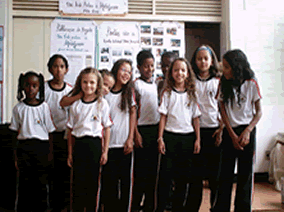
The team from
Dom Benevides State School at CEFET –Ouro Preto.
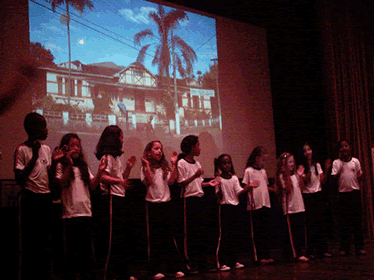
Show presented in the theater of CEFET –Ouro Preto.
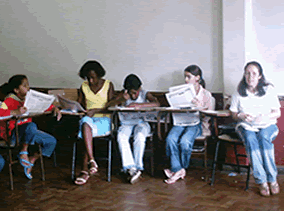
Activities
in the classroom of teacher Maria Auxiliadora.
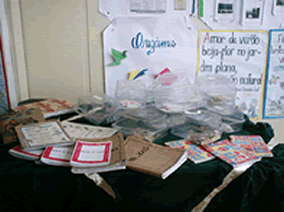
Display of
books made by the students.
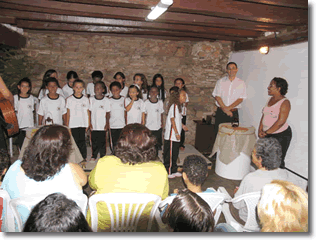
(Translated
by Andrew Fenwick Booth)